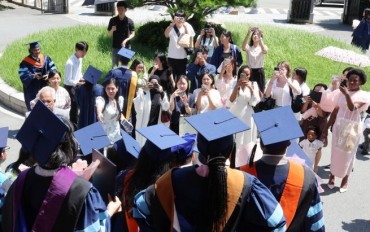
With a natural habitat limited to east-central China and Korea, the water deer, named for its affinity for water, carries out an uncertain existence. (Image: Yonhap)
SEOUL, Feb. 12 (Korea Bizwire) – With a natural habitat limited to east-central China and Korea, the water deer, named for its affinity for water, carries out an uncertain existence.
Despite a listing of ‘Vulnerable’ by the International Union for Conservation of Nature (IUCN), in South Korea the animal is thriving due to the extinction of natural predators such as Korean tigers and leopards.
The water deer are doing particularly well in the demilitarized zone, which has become something of a wildlife preserve thanks to the agreement between North and South Korea barring anyone from entering this strip of land running through the center of the Korean peninsula.
The populations of water deer have in fact become so robust that within South Korea the animals have become hunted instead of protected. Since 1994, water deer have been designated as “harmful wildlife”, a term given by the Ministry of Environment to wild creatures that can cause harm to humans or to their property.

Since 2000, local governments began carrying out efforts to trim population sizes as water deer numbers continued to grow, resulting in an increasing number of encounters between the animals and humans. (Image: Yonhap)
In 2016, the extent of the damage attributed to water deer was estimated at 2.46 billion won.
Since 2000, local governments began carrying out efforts to trim population sizes as water deer numbers continued to grow, resulting in an increasing number of encounters between the animals and humans.
Currently, certain local governments offer bounties from 30,000 won to 50,000 won during the farming season. However, the hunting of water deer is not restricted to the warm season, as 18 hunting grounds are currently in operation this winter.
With individual numbers estimated to range anywhere from 500,000 to 700,000, concern has been expressed that South Korea’s plentiful numbers of water deer could eventually dwindle to worrying levels.
Also pointed out as a problem is the cruel way hunters cut off water deer’s tails to provide proof for payment. Furthermore, as South Koreans shy away from eating the animal’s flesh due in some part to the handed down belief that eating water deer meat brings bad luck, opponents of hunting say the dead carcasses create their own environmental problems.
With a report by the Joongang Daily stating that 3,600 water deer in the Seosan region of South Chungcheong Province were captured or killed last year alone, how to best maintain a delicate balance between the wild deer and humans remains to be seen.
Lina Jang (linajang@koreabizwire.com)






